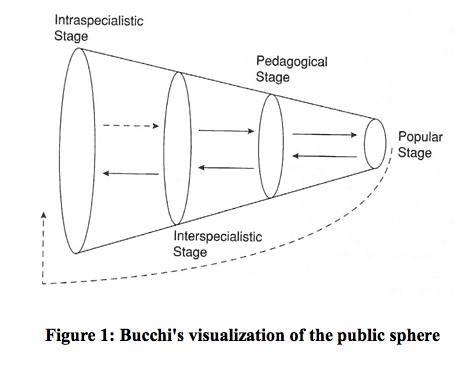Here are summaries for two more chapters from the Handbook of Public Communication of Science & Technology. First, Massimiano Bucchi’s overview of science communication theory provides a good framework for this book, and is something I’ll definitely revisit for my exam:
Summary: Discusses several models of sci. comm., which has arisen as a specialist field as science has become institutionalized and specialized. Bucchi presents a 4-level model for diffusion of ideas (continuity model), and then discusses three models for communication. In his continuity model, texts or ideas go through 4 levels (within a discipline, between disciplines, pedagogic, then popular), though they can jump levels (sometimes deliberately, to “shortcut” the usual process as new metaphors at the popular level are introduced to influence other scientists) or move in the opposite direction (again, metaphors @ popular level). At each step, uncertainty is removed & ideas become facts.
Bucchi dislikes idea of comm. as transfer between contexts (b/c of selective perception, non-linearity of comm., active transformation of ideas affecting sci. process); prefers idea of comm. as dialogue between specialist & popular discourses (with models & metaphors as “boundary objects”). (1) The traditional “deficit” model is 1-way and views media as an imperfect channel and public as passive (but able to understand once ideas are “translated”). The role of the scientist is to channel info to media (through press releases, celebrity scientists, prestigious journals). Public has an assumed deficit of knowledge b/c of scientific illiteracy (ability to reason scientifically; concept is countered by “different ways of knowing” idea (science=facts; lay=facts + values, trust, practical applications)). (2) “Dialogue” model includes citizen involvement as a way to enrich discussion (e.g., medicine.) (3) “Participation/co-production” model involves fora to set policy (involve multiple constituencies); this model links to broader discussion of science in society, e.g., non-academic institutions (NGOs, corporations) generating knowledge, open access vs. owned knowledge.
Comments: Continuity model will probably be useful. Another key concept is that different models could be applicable in different situations (deficit model the default in areas of low public interest); depends on level of public salience & mobilization, institutional/expert credibility, and the perceived level of controversy among scientists. Opening “black box” for public discussion leads to conflict and doesn’t fit into rhetoric of knowledge economy, so may be resisted by govt.; but public is not going to want to participate in drawn-out process in many cases. Modeling is fluid (e.g., public needs may change with new info or connection to new controversy) not static.
Connected to this is Edna Einsiedel’s chapter on public participation and dialogue:
Summary: Einsiedel focuses on the recent “participation explosion” in policy decision-making (esp. environment & health stakeholder participation). Public engagement can serve as quality control and create greater/more authentic democracy, but requires access to information, meaningful participation in decision-making, and access to judicial redress in case of problems. For her, a “deficit vs. dialogue” model is too simple- it’s a continuum including public feedback, participation, determining solutions, etc. Historical motivations include limits to expertise, controversies, social movements, and greater recognition of uncertainty. She identifies 4 trends: formalized forms of engagement (e.g., expert panels), increasing frequency of dialogue/participation planning, timing occurring throughout process (not just at end), and content of discussions expanding to include a broad range of values. There are a few main theoretical/normative frameworks for participation: deliberative democracy, technology assessment, deconstruction of “expertise,” and institutional contexts. One key problem is evaluating the process (what type of assessments to use); Einsiedel suggests including both “interested” (e.g., envtl. groups) and “disinterested” (e.g., unaffiliated citizens) parties in order to make sure that a range of views is expressed.
Comments: It seems that dialogue models are highly touted, but Einsiedel suggests that (like usability testing in tech design) organization of these fora can be driven by the need to legitimate decisions that have already been made or pay lip service to public airing of views. This is probably another reason to include organized pressure groups.



[…] to: Hellsten & Nehrlich (metaphors in sci. comm); Bucchi (metaphors for communication between disciplines) Possibly related posts: (automatically […]
By: Exam reading: “Crafting science” « Terpsinoe on September 22, 2010
at 8:27 pm
[…] to: Bucchi (similar discussion of lack of deficit-dialogue binary); Shamos (characterizes scientism as […]
By: Exam reading: “Towards an analytical framework” « Terpsinoe on March 16, 2011
at 4:01 pm
[…] to: Bucchi (bypassing levels of […]
By: Exam readings: how scientists see reporters, online persuasion « Terpsinoe on March 16, 2011
at 4:17 pm